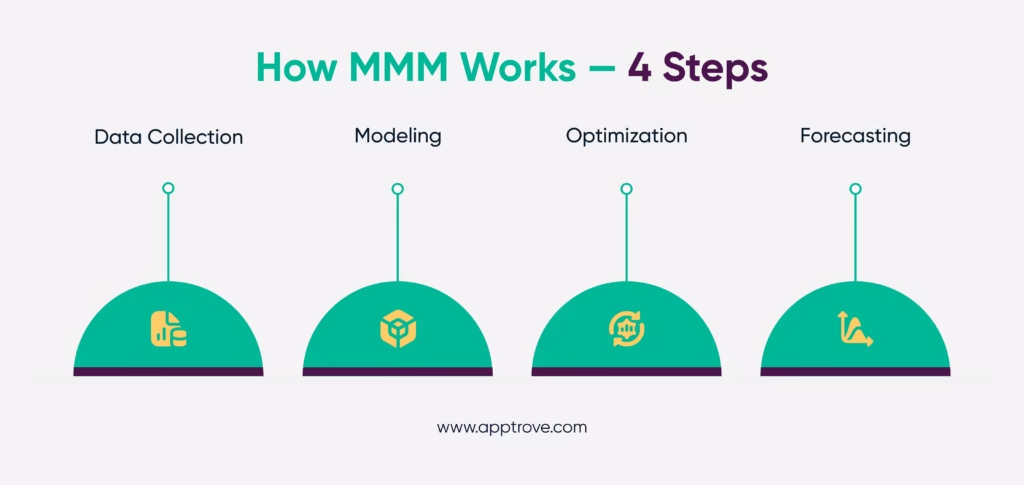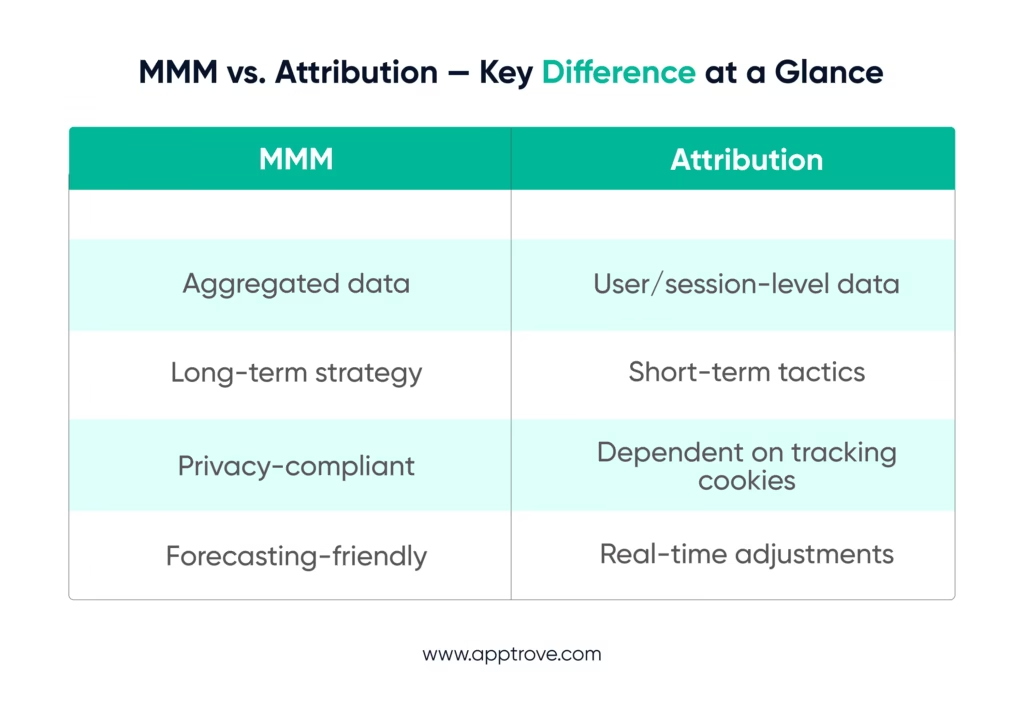What is Media Mix Modeling?
Media Mix Model is an analytical approach used to help you understand the influence of multiple marketing channels on performance across your entire business. Media Mix Modeling looks at historical data like ad spend, impressions, and sales to understand which channels are generating results, how they interact with each other, and how to reallocate future budgets to maximize return.
To put it plainly, Media Mix Modeling is like a “balance sheet” for your marketing. It doesn’t just provide insights about which channels are working; it shows how much economic value each channel is providing. Whether you have spent time happening in search, social, TV, influencer marketing, or new app channels, Media Mix Modeling will help identify where your customer paths become complicated with multiple touchpoints.
Marketers today work in a privacy-first world with fewer tracking abilities, rapidly declining cookies, and consumer behavior often includes dozens of touchpoints. That is where MMM comes in extremely useful; it provides data-driven recommendations without having to rely on user-level data.
Why Media Mix Modeling is More Important Than Ever
The digital advertising environment is changing faster than most teams can adapt. Once upon a time, attribution models showed you the ad (or ads) that provoked a conversion (whether based on last-click or multi-touch) so you could collect data to make decisions. Now, due to privacy restrictions like GDPR, CCPA, and Apple’s App Tracking Transparency (ATT), tracking individually identified pieces of data is less reliable.
With Media Mix Modeling (aka MMM), you can avoid these problems because it is based on aggregated (not attributed) and historical (not real-time) data. This means the process is privacy compliant, and it offers consistency over time.
In fact, according to a study by Measured (April 18, 2025), reallocating the budget toward more effective channels, guided by Marketing Mix Modeling insights, resulted in a 10-15% increase in marketing ROI. Moreover, recent analysis suggests that organizations leveraging MMM for budget optimization typically see a 15–20% boost in marketing ROI, and in some cases, up to a 50% improvement.
As ad spend tightens and competition increases, the use of MMM could be the difference between being able to scale profitably and throwing more dollars towards channels that lose you money.
How Media Mix Modeling Works

MMM is essentially a regression analysis (or other statistical techniques) that relates marketing inputs to business results. The process typically includes:
- Data Collection: Research the historical marketing spend, impressions, conversions, seasonality, economic variables, and any other external events.
- Modeling: Use statistics to determine the correlation and contribution of each channel to sales or app installs.
- Optimization: Use the results to reallocate advertising spend to channels that yield the highest returns.
- Forecasting: Predict how changes in spend on different channels will affect channel performance in the future.
While many attribution methods are “real-time,” MMM is more beneficial with historical and comparable data over a longer time period, usually 12 – 24 months. A significant advantage of this longer time horizon is that the model takes into consideration outside factors, such as brand-building campaigns that have a longer time horizon before contributing meaningfully to conversions.
Media Mix Modeling vs. Attribution

Although Media Mix Modeling and attribution both seek to examine marketing effectiveness, they follow different practices. Attribution usually works at the user or session level, in that it gives credit for a conversion to one or more touchpoints in the customer’s journey.
MMM does not track individual users; rather, it uses aggregated data to evaluate the performance, in terms of lift in conversions, of overall channels over time. It employs the question: If I increase my spend on this channel by 10%, what increase do I expect in conversions?
The best marketers leverage both practices of marketing measurement in their practice. Attribution aids in short-term tactical initiatives, while Media Mix Modeling allows marketers to forecast the effectiveness of a tactical budget into a long-term strategic budget. Together, they also allow you to test incrementality: Whether your campaign generated additional results or simply captured conversions that would have occurred anyway.
Key Benefits of Media Mix Modeling
1. Privacy-First Measurement
As tracking restrictions become more common, MMM provides a measurement approach that aligns with privacy laws and user expectations.
2. Long-Term Strategy Alignment
MMM provides you with key insights into channels that take longer to impact consumer behavior, like TV ads or brand-building campaigns, that attribution models often undervalue.
3. Improved Budget Allocation
By quantifying the return on media dollars from each channel, you can confidently shift budget toward your top-performing performers and eliminate waste.
4. Forecasting Capability
MMM isn’t just about what happened in the past; it’s about predicting the future. This at-a-glance forecasting power helps you run “what-if” scenarios for the media campaigns you are working on.
Media Mix Modeling: Common Challenges
Although it has a lot of benefits, there are challenges related to MMM.
- Data Quality: The accuracy of the model will be compromised if the input data is incomplete or inconsistent.
- Time Lag: MMM can only provide feedback based on historical data.
- Complexity: MMM requires statistical know-how, planning, and adjustments along the way to build and maintain.
Fortunately, advanced analytics tools like Apptrove and more sophisticated data sources make it easier to adopt Media Mix Modeling because they combine aggregated data in a variety of traditional and digital media assets, then visualize results in an easy-to-use dashboard.
How Media Mix Modeling Supports Incrementality Testing
Incrementality is the concept of measuring the true lift of a marketing activity. Media Mix Modeling is in a natural position to be used in incrementality testing in that it distinguishes correlation from causation. For example:
- If you have spikes in app installs after a TV campaign, how do you know if this is due to the TV ads or if there is seasonal demand at play?
- MMM can compute that by controlling for externalities and isolating the growth from the campaign.
While this is a very important element of performance reporting, it is critical to mitigate the risk of false positives in any performance data. It is not actionable to scale a campaign based on it simply appearing to be working.
Media Mix Modeling 101: Best Practices
- Collect Enough Historical Data: Use a minimum of 12 months with continuous channel-level spend and performance data.
- Include Elements Outside the Marketing Plan: Evaluating seasonality, holidays, shifts in the market, and economic conditions can help provide a model that is more closely aligned with reality.
- Keep it Simple: Start with a base model consisting of your top 3-5 channels. Begin with these channels, make adjustments to your base model until you get comfortable, and add complexity over time.
- Have Experimentation: Use A/B testing in conjunction with MMM to validate and ensure you measure the right influences for your marketing mix.
- Review Quarterly: Consumer behavior is a moving target, and your model must be recalibrated regularly for changing behaviors within each phase of the purchase funnel.
Media Mix Modeling within the Mobile App Environment
Media Mix Modeling (MMM) is extremely valuable for mobile app marketers since it integrates the best of user acquisition marketing with brand marketing. MMM takes into account app installs, in-app purchases, subscription renewals, and ad-driven monetization. As such, you will develop a map of everything that is driving growth for your mobile app.
The Map is especially valuable in spaces like gaming, fintech apps, and commerce apps, where you have multiple paid channels operating at the same time. You’ll be able to uncover patterns, such as organic growth outpacing other channels following a paid campaign, or how influencer awareness organically built around an app lifted paid search performance.
Apptrove’s platform extends this further by merging MMM with attribution practices focused specifically on mobile, so you can understand and execute on insights that cut across both short-term and long-term.
The Future of Media Mix Modeling
With advancements in AI and machine learning, MMM will become faster, agile, and more accessible to marketers who do not have a data science background. As automated modeling, scenario planning in real time, and connections to automated marketing platforms become mainstream, MMM will be the center of every data-driven marketing strategy.
Yet, the human aspect is essential—while models can point to where to spend, marketers still need to generate insights on behalf of the brand through the lens of the audience and market development.
Conclusion
Media Mix Modeling is not another marketing buzzword—it is a proven, privacy-safe method with lots of data behind it to help make better budget decisions. In a fragmented, fast-changing advertising ecosystem, MMM can give you the clarity and confidence to reduce wasted spend, allocate more to winners, and forecast opportunity cost.
If done right, Media Mix Modeling tells you where your money went, as well as where you should be putting that money moving forward. With Apptrove‘s advanced analytics and attribution capabilities, you can begin to turn MMM learnings into meaningful business outcomes.